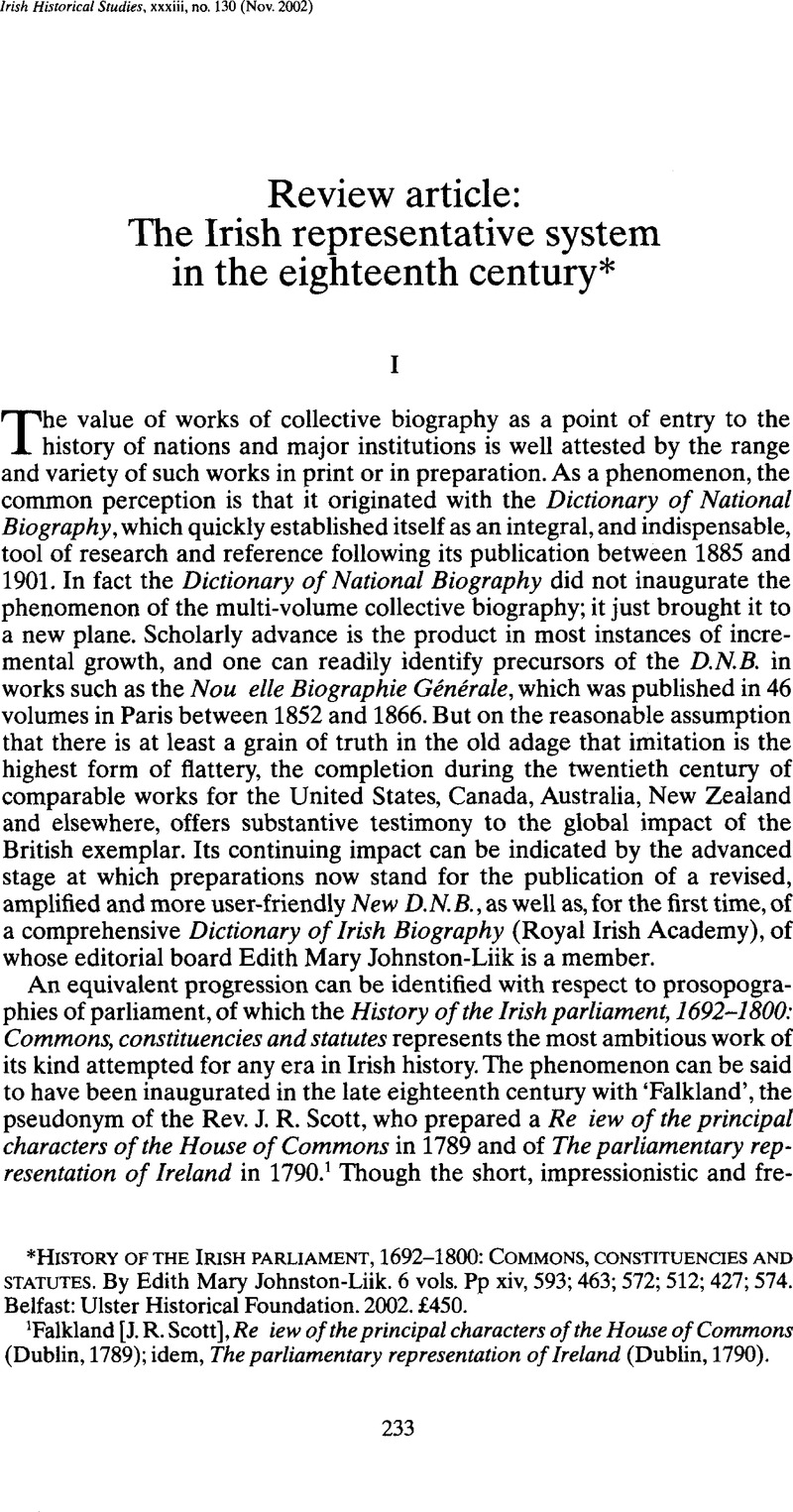No CrossRef data available.
Article contents
The Irish representative system in the eighteenth century*
Published online by Cambridge University Press: 21 March 2016
Abstract

- Type
- Review Article
- Information
- Copyright
- Copyright © Irish Historical Studies Publications Ltd 2002
Footnotes
History of the Irish parliament, 1692-1800: Commons, constituencies and statutes. By Edith Mary Johnston-Liik. 6 vols. Pp xiv, 593; 463; 572; 512; 427; 574. Belfast: Ulster Historical Foundation. 2002. £450.
References
1 Falkland, [Scott, J. R.], Re iew of the principal characters of the House of Commons (Dublin, 1789)Google Scholar; idem, The parliamentary representation of Ireland (Dublin, 1790).
2 Public Characters, 1798-1808 (10 vols, London, 1799-1808).
3 Oldfield, T. H. B., The representati e history of Great Britain and Ireland (6 vols, London, 1816).Google Scholar
4 Edward, and Porritt, A. G., The unreformed House of Commons (2 vols, London, 1903).Google Scholar
5 Hamilton, F. B., The picture of parliament, containing a biographical dictionary of the Irish members … (Dublin, 1831).Google Scholar
6 Earl of Belmore, Parliamentary memoirs of Fermanagh and Tyrone, 1615-1885 (Dublin, 1887)Google Scholar; Burtchaell, G. D., Genealogical memoirs of the members of parliament for the county and city of Kilkenny (Dublin, 1888).Google Scholar
7 Tennison, C. M., ‘Cork members of parliament, 1559-1800’ in Cork Hist. Soc. Jn., 2nd ser., i (1895), pp 39–42, 73-6, 117-80, 176-80, 230-34, 276-80, 322-8, 377-80, 421-5, 471-5, 522-5, 561-2Google Scholar; ii (1896), pp 37-40, 136-9, 178-81, 225-7, 274-7, 323-6, 368-70; Sadleir, Thomas Ulick, ‘Kildare members of parliament’ in Kildare Arch. Soc. Jn., vi (1909-11), pp 398-06Google Scholar, 469-92; vii (1912-14), pp 41-4, 109-16, 154-67, 234-41, 311-16, 393-410; viii (1915-17), pp 71-5, 150-56, 197-203, 302-8, 399-403, 495-502; Smyth, T. S., ‘Members of the Irish parliament for Cavan county and the boroughs of Cavan and Belturbet’ in Breifny Antiq. Soc. Jn., 1920, pp 37–47Google Scholar; 1921, pp 95-111.
8 Johnston, E. M., ‘Managing an inheritance: Colonel J. C. Wedgwood, the History of Parliament and the lost history of the Irish parliament’ in R.l.A. Proc, lxxxix (1989), sect. C, pp 7–8Google Scholar; Colley, Linda, Lewis Namier (London, 1989), pp 73-4.Google Scholar
9 Johnston, ‘Managing an inheritance’, p. 172; Colley, Namier, pp 75-6.
10 Johnston, ‘Managing an inheritance’, pp 171, 178-80.
11 Namier, L. B. and Brooke, John (eds), The History of Parliament: the House of Commons, 1754-90 (3 vols, London, 1964)Google Scholar. In addition, the following overlap with the History of the Irish parliament: Sedgwick, Romney (ed.), The History of Parliament: the House of Commons, 1715-54 (2 vols, London, 1970)Google Scholar; Henning, B. D. (ed.), The History of Parliament: the House of Commons, 1660-90 (3 vols, London, 1983)Google Scholar; Thorne, R. G. (ed.), The History of Parliament: the House of Commons, 1790-1820 (5 vols, London, 1986)Google Scholar; Cruickshanks, Eveline, Handley, S. N. and Hayton, D. W. (eds), The History of Parliament: the House of Commons, 1690-1715 (5 vols, Cambridge, 2002).Google Scholar
12 See Colley, Namier, pp 78-84; The making of an historian: the collected essays of J. H. Plumb (Brighton, 1988), pp 108-12; Hoppit, Julian (ed.), Failed legislation, 1660-1800: extracted from the Commons and Lords journals (London, 1997), p. 1.Google Scholar
13 Evans, Richard J., In defence of history (London, 1997), p. 35.Google Scholar
14 Johnston, E. M., Great Britain and Ireland: a study in political administration, 1760-1800 (Edinburgh, 1963; repr., 1978).Google Scholar
15 Johnston-Liik, Hist. Ir. parl., i, 2.
16 Quoted ibid., p. 209. See also, Hoppit (ed.), Failed legislation, p. 1.
17 For the most recent considerations of Poynings’ Law in eighteenth-century Ireland see Bergin, John, ‘Poynings’ Law in the eighteenth century’ in Pages: postgraduate research in progress (University College Dublin), i (1994), pp 9–18Google Scholar; Kelly, James, ‘Monitoring the constitution: the operation of Poynings’ Law in the 1760s’ in Parliamentary History, xx, no. 1 (2001), pp 87–106.Google Scholar
18 Johnston-Liik, Hist. Ir. part., ii, 372-88.
19 Ibid., pp 184, 238 (for quotations).
20 Power, Thomas, ‘Parliamentary representation in County Kilkenny in the eighteenth century’ in Nolan, William and Whelan, Kevin (eds), Kilkenny: history and society (Dublin, 1990), pp 305-32Google Scholar; Kelly, James, ‘The politics of “Protestant ascendancy” in County Galway, 1650-1832’ in Moran, Gerard (ed.), Galway: history and society (Dublin, 1996)Google Scholar; Murtagh, Thomas, ‘Power and politics in County Galway, 1770-1832’ (unpublished M.A. thesis, University College Galway, 1982).Google Scholar
21 Power, ‘Parliamentary representation in County Kilkenny’, pp 305-32.
22 Johnston-Liik, Hist. Ir. parl., i, 4.
23 Evans, In defence of history, p. 35.
24 Hoppit, (ed.), Failed legislation; Parliamentary History, xx, no. 1 (2001).Google Scholar
25 Hayton, D. W., ‘Introduction’ to Parliamentary History, xx, no. 1 (2001), pp 1–25.Google Scholar


